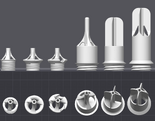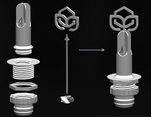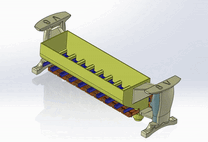
Goal
The goal of this project was to develop a standardized hydroponic growing system that utilizes Lyrata's SmartSoil grow medium with better access for remote/local hydroponic growing. By utilizing 3D printing technology, we could potentially manufacture most of the equipment and tools remotely to achieve this. To develop the hydroponic growing system, the physical system, which includes the circulation system, mechanical structure, lighting system, water chemistry, and monitoring system, was to be designed, prototyped, iterated, and validated. A standard operational protocol (SOP) was also needed to be created.
This project walkthrough will focus on the sustainability and hardware aspects of this project, specifically the development of three example sub-projects - drainage system, SmartSoil dispenser, and netcup dispenser
Background[edit | edit source]
The Company, Lyrata Inc., was founded in 2021 and won the NEST Competition at the University of Toronto's Hatchery Entrepreneurship. I wasn't part of it to start with, but rather, I joined as a mechanical designer co-op student in summer 2022 and started vesting as a co-founder 6 months later.
A 3D-printable and reusable hydroponic grow medium named "SmartSoil" was what Lyrata was developing. This newly invented SmartSoil emits 88% less carbon than competitor products in the production process. Since it is 3D-printable, it is also suitable for remote production, which makes it much easier accessible to rural areas like Northern Canada.
The company has somewhat validated the growth performance of SmartSoil at this time, but there were dozens of technical and business challenges. One that stood out the most is that most hydroponic farms have their infrastructure and operations built around major commercial hydroponic grow mediums like Rockwool, while Lyrata's SmartSoil doesn't work as well with these established infrastructures and operations. This made it impractical for SmartSoil to be commercialized as a stand-alone product like other grow mediums. The only way to make SmartSoil work in commercial settings was to create a new system for it, which included creating the infrastructures and the operational standards.
Research and Development[edit | edit source]
Drainage System[edit | edit source]


Commercial hydroponic drainage pieces always involve nets or meshes to prevent leaves and roots from flowing down. However, they require regular clean-ups because as leaves and roots build up around drains, water flow gets blocked, and water levels tend to go up. This usually results in a low water flow rate, which leads to low dissolved oxygen levels in water and makes roots suffocate. Worse case, if drains are blocked by too much, water may overflow. Growers always have to clean up drains frequently. Some growers use air pumps and air stones to increase dissolved oxygen levels, but air pumps drain electricity constantly, and air stones are very hard to clean. This led me to investigate simpler ways to increase dissolved oxygen levels in water.
Through iterations, a new drain was developed and tested as shown in the attached image "Air Drainage". The idea was to create a consistent mixture between water and air within the drainage tube connecting two tiers. The vertical screw-like tunnel in the center makes sure that water never flows down without mixing with air. This mixture action can be easily observed by small bubbles formed at the bottom tier around the connecting tube. Through experiments on manipulating the size and length of the "screw", I achieved an ideal bubble size that is not too small that wouldn't be effective in dissolving oxygen and also not too big that would splash water onto raft boards.
As shown in image "Air Drainage", in iteration 3 to 5, there are patterns or shapes on the design to create a rotating turbulence. In fact, It resulted in faster water flow speed and created even more collisions between water and air. However, it made the piece much harder to clean and as a result, this feature was deleted on the final iteration. The four "flaps" on the last two iterations were there to prevent raft boards from being lifted midway and to improve the handleability of this piece for screwing on and off. The piece is easily 3D-printable without support. A complete set of drainage systems, as shown in the image "Drainage Set," was also designed, prototyped, and validated.

To eliminate the possibility of dead leaves and roots running in the system and potentially block drains, a filter tool as shown in image "Leaves Filter" was developed. To use this, a mesh is placed in between the piece B and C and fixed by the sparks on piece B. Only one of this filter is needed for each unit. The body is wide enough that it need much less frequent cleaning. It is also easy to clean thanks to its "drawer" design. The drainage set and the leaves filter works together to ensure rich dissolved oxygen in water, quick and easy clean-ups of solid material in water, and consistently high water flow rate without the risk of overflowing.
SmartSoil Dispenser[edit | edit source]



To make SmartSoil commercially viable, we needed to make it easy to be handled, so I started investigate on methods to dispense these pallet conveniently. Ideally there could be a tool that can easily dispense a pre-set amount of SmartSoil in one motion. It would also be great if the same mechanism could also be suitable for automation in the future.
There are tool or machine that serve similar purposes like candy dispenser or fish food dispenser for my reference but they were not applicable for SmartSoil because SmartSoil pallets are solid, small, and yet rough. They cannot be easily broken like fish food, nor can it be dispensed one at a time like hard candys since multiple (12~16) needed to be dispensed at each time and they could easily jam the motion by their rough surface.
The general idea is simple as shown in figure "SmartSoil Dispensing Motion Draw up" on the right. You segment a pre-set volume of the pallets and dispense them by opening up from the bottom. The hardest part was to segment the volume out without jamming the motion (step 2 - step 3 in figure "SmartSoil Dispensing Motion Draw up"). I did serval feasibility test with paper, plastic sheet, brushes, and 3d-printed shove-like pieces as the segmentation tool. None of them were able to cut through with consistency. I also tried other form of segmentation but there is always at lease one corner where the PLA pallets jams easily. I was dying for new ideas until I realized maybe there is a way to segment the volume without consistently cutting through. Maybe there is a way to make use of the jamming senerio if I could manage to bare with the inconsistant travel of the segmentation tool (Blue line in image "SmartSoil Dispensing Motion Draw up"). With this idea, I made the first version of SmartSoil dispenser and prototyped it with four 3D printed pieces and two springs as shown in figure"Soil Dispenser - First Version".
The "segmentation tool" (Orange part in figure "Soil Dispenser - First Version") is tied to the body (Grey part in image "Soil Dispenser - First Version") using a tension spring so it is also being pull towards left. To use this tool, an operation needs to use one hand to hold on to the body and use the other hand to pull the "Under Door" (blue part in figure "Soil Dispenser - First Version") to the right most (reloading) and to the left most (releasing). In case there are SmartSoil pallets preventing the segmentation tool to return to default location, well... it does not matter because it dose not jam the travel of the "Under Door" and, by jamming, it is preventing any pallets from entering the pre-set volume from above.
By testing, this worked perfectly as expected. After a few iterations with the goal of making this Soil Dispensing tool more agronomical and more efficient, I arrived at version 11 as shown in figure "Soil Dispenser - 11th Version" on the right. This design has been used by our growing team for a year, and it has significantly improved SmartSoil's sowing efficiency.